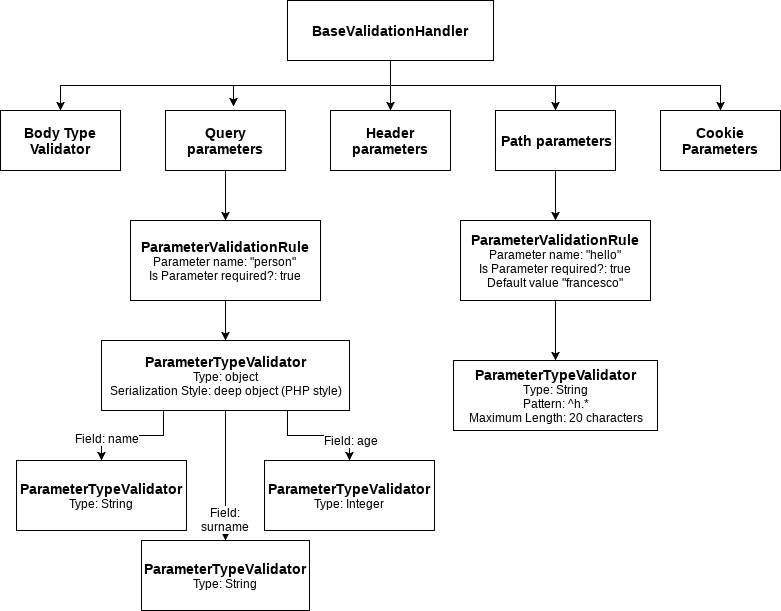My GSoC 2017 - Requests validation
HTTP request validation it’s a critical component of my project. HTTP requests validation needs to work well to get working all layers upon. I love to call that vertx-web validation framework (I love the word framework 😍)
Structure of Validation framework
The validation framework is located inside maven module vertx-web and package io.vertx.ext.web.validation. Following the Vert.x rules, there are Java interfaces for polyglot vertx-web interface and classes inside io.vertx.ext.web.validation.impl that implements the logic of the validation.
HTTPRequestValidationHandler and OpenAPI3RequestValidationHandler (request validator for OAS3) subclass BaseValidationHandler, the base class for validation. This class contains a map with parameter names as keys and ParameterValidationRule instances as values for every parameter location (query, path, header, cookie, form inside body). Every ParameterValidationRule contains a ParameterTypeValidation. To simplify things:
BaseValidationHandlervalidates the request, in fact it iterates through parameters and callsParameterValidationRulemethodsParameterValidationRuleabstracts a parameter and validates if parameter exists, if can be empty, …ParameterTypeValidatorabstracts the parameter type and validates the type

Every exceptions of validation framework are encapsulated inside ValidationException class.
Types of parameters
Most important part of validation is type validation. Type validation take a string or a list of strings as input and gives the parameter correctly parsed as output. I’ve built a rich set of type validators (mostly to support OpenAPI 3 parameter types):
NumericTypeValidatorto validate integers and floating point valuesStringTypeValidatorto validate strings against a patternBooleanTypeValidatorto validate booleansJsonTypeValidatorandXMLTypeValidatorto validate json and xml against a schemaEnumTypeValidatorto validate enumsObjectTypeValidatorandArrayTypeValidatorto validate objects and arrayAnyOfTypeValidatorandOneOfTypeValidatorto validate json schema likeanyOfandoneOf
To instance this classes, there are static methods inside ParameterTypeValidator. Of course, user can subclass ParameterTypeValidator to create its custom type validator.
I’ve also created a set of prebuilt instances of this type validators inside ParameterType enum, with some common patterns like hostname, email, …
Encapsulating parsed parameters
After type validation parameter is parsed and then encapsulated in an object called RequestParameter. Every object is mapped into equivalent language type, for example: if we declare a parameter as integer, we receive (in Java) Integer object.
When user wants to handle parameters, he can retrieve the RequestParameters from RoutingContext. RequestParameters encapsulate all RequestParameter objects filtered by location. For example:
1 | router.get("/awesomePath") |
Arrays, objects and serialization styles
User can declare arrays and objects as parameters. The ObjectTypeValidator/ArrayTypeValidator provides the deserialization from string, the validation of objects fields/array items with “nested” validators and the encapsulation inside map/list. For example, you can declare a query parameter as comma separated array of integers like this one: ?q=1,2,3,4,5 and you will receive as result a List<Integer>.
The serialization methods are implemented as subclasses of ContainerDeserializer and there are some prebuilt instances in enum ContainerSerializationStyle. Of course, user can use static methods inside ObjectTypeValidator.ObjectTypeValidatorFactory and ArrayTypeValidator.ArrayTypeValidatorFactory to build this validators, define its serialization style and add the “nested” validators.
HTTPRequestValidationHandler
To start validate the requests, developers can use the HTTPRequestValidationHandler. This class exposes methods to add validators without care about ParameterValidationRule, because they are automatically generated. For every parameter location HTTPRequestValidationHandler exposes three methods:
add*Param: to add a parameter with type taken fromParameterTypeenumadd*ParamWithPattern: to add a string parameter with a patternadd*ParamWithCustomTypeValidator: to add a parameter with an instance ofParameterTypeValidator
Then there are methods for body, like addJsonBodySchema or addMultipartRequiredFile
Next time I’m going to introduce you the OAS 3 Router Factory, stay tuned!